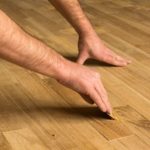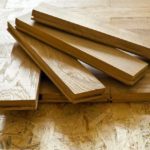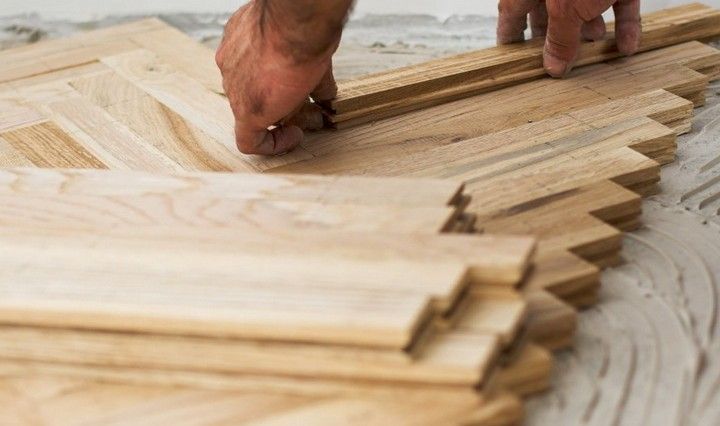Parquet varnishing
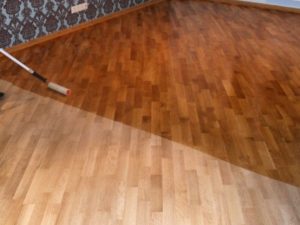 Any parquet, regardless of its cost or quality, sooner or later loses its original shine. This happens because the layer of varnish covering it wears out over time, becomes covered with scratches and chips.
Any parquet, regardless of its cost or quality, sooner or later loses its original shine. This happens because the layer of varnish covering it wears out over time, becomes covered with scratches and chips.
Varnish not only adds shine to wood, but also favorably emphasizes its texture and protects it from the aggressive effects of moisture and chemical detergents. Therefore, the service life of parquet floors that are deprived of such protection is significantly reduced. To “reanimate” the parquet flooring, you will need to re-varnish it.
The content of the article
Materials and tools for varnishing
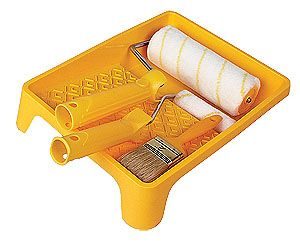
Before you start varnishing, you will need to prepare the necessary tools and paint material for the job. To carry out painting work you will need the following.
- Roller. It can be either synthetic or natural. The main condition is that the length of the pile of the “coat” should be 8–10 mm, which is best suited for applying liquid varnish.
- A high-quality wide brush that does not leave streaks or hairs on the surface being painted.
- Roll-out bath.
- Sander.
- Vacuum cleaner for removing dust after sanding.
- Spray gun.Useful for applying liquid paints and varnishes to large areas of floors.
How to choose a varnish
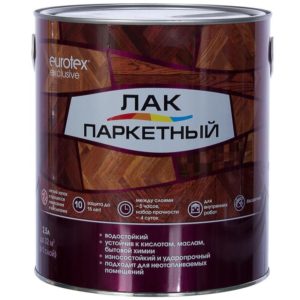
Particular attention should be paid to the choice of product. The composition should be parquet, that is, resistant to abrasion and interacts well with wood.
In any modern construction supermarket you can find a large assortment of parquet varnishes from various manufacturers. They are produced on different bases, which determine their performance properties.
- Water based. The so-called household series. Designed for painting floors in residential areas with low traffic intensity.
- Alkyd. Another type of household product that has one drawback is a pronounced chemical smell.
- Polyurethane. A composition of increased wear resistance class, suitable even for painting parquet floors even in public buildings: educational, administrative, shopping and entertainment, etc.
- Acrylic. They are safe for humans because they do not contain harmful chemicals.
REFERENCE. Varnishes can be transparent and tinted, giving the wood a certain color: oak, walnut, wenge.
In this case, they act as an analogue of stain. After preparing all the necessary tools and purchasing the necessary varnish, you can begin to work.
Preparation for applying the varnish layer
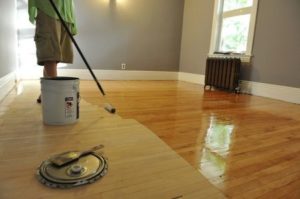
Before starting varnishing, you should prepare the workspace and the floors themselves. It is strictly not recommended to apply varnish to an unprepared surface.
Preparing the premises
Before starting work, you should remove all unnecessary things and furniture from the room. Nothing should interfere with painting with varnish in one step.So you don't have to wait for one half to dry before starting work on the other.
IMPORTANT! The recommended air temperature in the room should be in the range from +15 to +25 ° C, and the humidity should not exceed 60%.
With high humidity, the floor will take too long to dry, and the quality of the paint will be lower. Therefore, the room should be thoroughly ventilated before work, thereby reducing the humidity level.
Looping
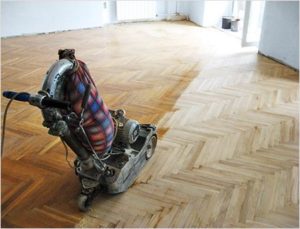
Before restoration, the parquet surface must be thoroughly cleaned of old varnish and wax rubbing. All this significantly reduces the adhesion of the applied varnish to the wood, and it will simply peel off over the next year.
To clean the floors, the parquet is scraped using a special sanding machine or a coarse-grain sander. During the sanding procedure, all dirt and old paintwork must be removed. As a result, only a clean, wooden parquet surface should remain.
Looping is a fairly dusty job, so it needs to be done in a well-ventilated area. For example, with open balcony doors and windows, weather permitting. Otherwise, you should protect your respiratory system with a respirator. The remaining dust after cleaning the parquet is removed using a powerful vacuum cleaner, and after that wet cleaning is also carried out.
Primer
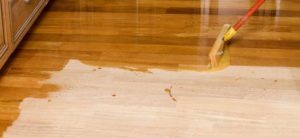
Next, you should carefully inspect the floors for chips or deep cracks. They are sealed with wood putty using a spatula. Then the surface of the parquet needs to be painted with a primer composition. Its purpose is to improve the adhesion of the varnish to the surface being painted, so that the varnish lays more evenly and stays on the parquet longer.
For primers, you should purchase special compounds designed for working with wood.Primers for concrete and iron are also available for sale: these types are not suitable for treating parquet floors.
IMPORTANT! Varnishes and primers with different chemical compositions can come into conflict with each other.
As a result, the varnish, instead of lying firmly on the wood, will flake off, peel and become covered with whitish spots. Therefore, it is recommended to select varnishes and primer compositions of the same chemical composition, and even better, from the same manufacturing company.
How to properly varnish parquet
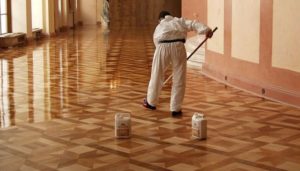
To obtain a strong and durable coating, several layers of varnish will be required. Depending on the consistency of the composition, there can be up to 5 or even 7. There is no need to be lazy and try to save money. A protective layer that is too thin will quickly wear off, and all the work will have to be repeated again next year.
Methods of applying the composition
There are several ways to apply varnish.
Using a brush
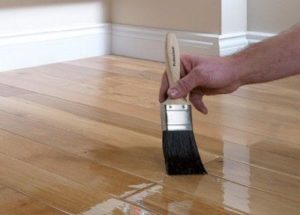
The varnish is best applied with broad strokes in the shape of the Latin letter U. The composition in this case applies quite smoothly.
The only drawback of this method is that the bristles of the brush seem to lift the wood fibers when painting. Therefore, mandatory intermediate sanding is necessary between the application of different layers.
Roller
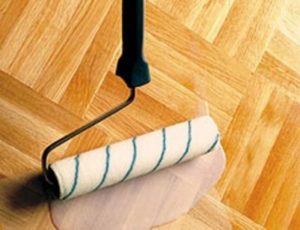
It is better to apply the varnish in a crisscross motion. This way the floors are painted better and more evenly, leaving no unaffected spots or stripes.
Spray
It is used when it is necessary to cover large areas, for example, lobbies and corridors of public buildings, stages and auditoriums.
It is characterized by increased consumption of paint and varnish materials, as well as the need to organize the protection of walls and windows from sprayed paint and varnish material.
Spatula
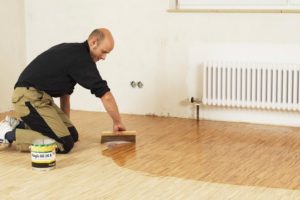
The thick varnish can be applied to the floors using a wide metal spatula using an S-shaped hand motion. However, if you do not have some experience with this tool, it is better to choose another technology.
Grinding
On average, each layer of varnish takes from 1 to 3 days to dry, depending on the air humidity in the room and the composition.
After the first layer has completely dried, intermediate sanding will be required. It is necessary to remove wood fibers “raised” by a brush or roller. Cleaning is done either manually, with sandpaper, or using an electric sander.
At the end of sanding, remove the resulting dust with a vacuum cleaner, wipe the parquet with a damp cloth and begin applying the second layer.
Useful tips
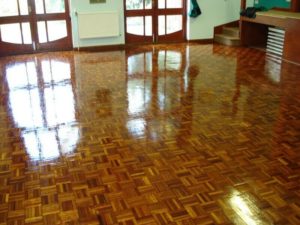
Varnishing parquet is a rather delicate procedure and requires knowledge of the “behavior” of paint and varnish products.
- Under no circumstances should drying be accelerated using a fan or heat gun. This may cause bubbles, stains and clouding to appear on the varnished surface.
- When choosing chemical-based varnishes, it should be taken into account that after drying, its color will become 1-2 shades darker due to a chemical reaction with the wood.
- The exception is aquatic varieties, which do not change their shade during the drying process.


